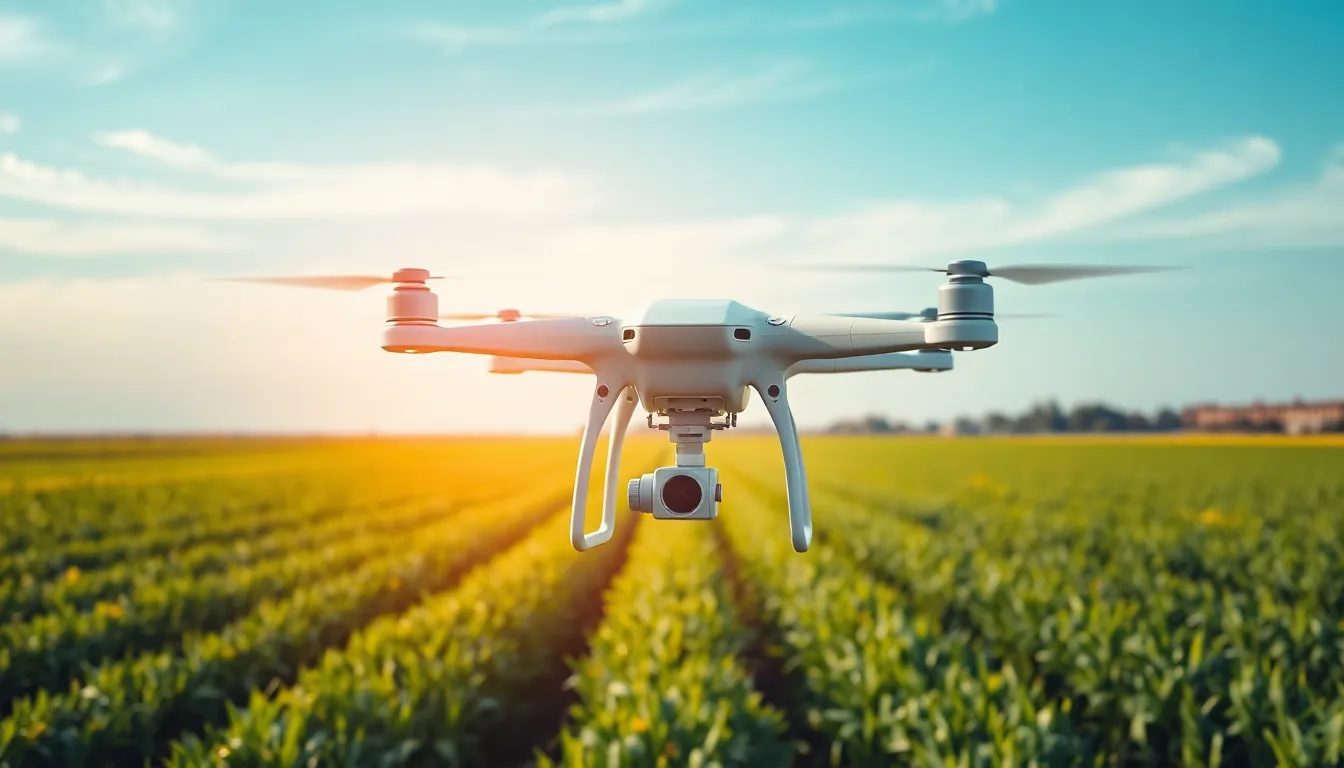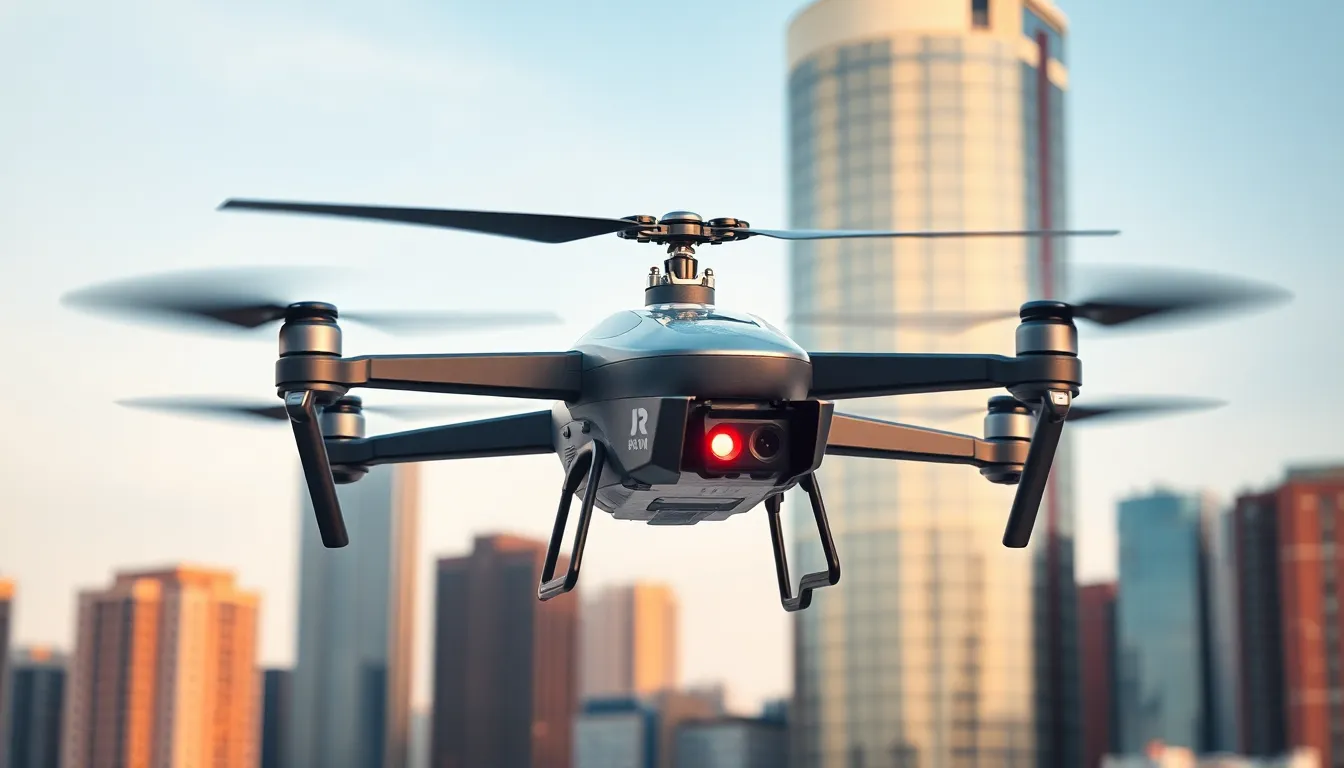In a world where flying cars are still a dream, helicopter drones have swooped in to steal the spotlight. These buzzing marvels of technology combine the thrill of aviation with the convenience of remote control, making them the perfect gadget for enthusiasts and professionals alike. Imagine zipping through the sky with a bird’s-eye view while your friends are stuck in traffic—now that’s a scene straight out of a sci-fi movie!
Table of Contents
ToggleOverview of Helicopter Drones
Helicopter drones, often referred to as multirotors, possess unique characteristics that distinguish them from traditional fixed-wing drones. These aircraft feature multiple rotors that allow for vertical takeoff and landing capabilities. They provide exceptional maneuverability, making them ideal for various applications, including aerial photography, surveillance, and search and rescue operations.
The design of helicopter drones facilitates a stable flight experience, which appeals to both hobbyists and commercial operators. Their ability to hover in place enhances their utility in capturing detailed images and videos from different angles. Users find it easier to control helicopter drones due to their intuitive flight controls and responsive handling.
Battery life concerns exist with helicopter drones, typically ranging from 15 to 30 minutes, depending on the model and payload capacity. Various manufacturers continue to innovate, developing batteries with higher energy densities to extend flight times. Costs for these drones vary significantly, with basic models starting around $100 and professional-grade options exceeding $10,000.
Regulatory considerations play a critical role in helicopter drone operations. The Federal Aviation Administration (FAA) mandates compliance with specific guidelines, particularly for commercial use. As regulations evolve, awareness of airspace restrictions and operational best practices becomes essential for users.
Users can also benefit from advanced features such as GPS navigation, obstacle detection, and automated flight modes. These enhancements not only simplify operations but also improve safety. Many helicopter drones now incorporate smart technology, allowing for real-time data transmission and integration with mobile applications.
Overall, helicopter drones represent a compelling blend of technology and practicality, making them versatile tools in today’s aviation landscape.
Applications of Helicopter Drones

Helicopter drones serve a variety of practical applications across different sectors. Their unique capabilities make them indispensable in many fields.
Commercial Uses
Commercial sectors leverage helicopter drones for tasks like aerial photography and real estate promotion. Many industries, such as agriculture, benefit from drone technology for crop monitoring and precision farming. Inspection services utilize these drones for surveying infrastructure, including power lines and bridges. Delivery services explore the potential of drones to transport goods, significantly reducing delivery times. Data gathering and mapping also rely on helicopter drones to capture high-resolution images, making them valuable in urban planning.
Military Applications
Military operations employ helicopter drones for reconnaissance and surveillance missions. Real-time data collection enhances situational awareness and supports tactical decisions. Identifying targets becomes more efficient, given the drones’ ability to fly at low altitudes and gather intelligence. Search and rescue missions in challenging environments rely on these drones to assess conditions and locate victims. Logistics and supply chain management also utilize helicopter drones for delivering medical supplies and equipment to remote or contested areas.
Advantages of Helicopter Drones
Helicopter drones offer numerous advantages that make them appealing for various applications. Their unique design contributes to the benefits they provide.
Enhanced Maneuverability
Maneuverability stands out among helicopter drones’ key advantages. The multiple rotors enable precise control, allowing these drones to hover in place seamlessly. They can navigate tight spaces, making them ideal for indoor inspections or urban environments. Whether capturing detailed footage or conducting surveillance, their agility enhances performance dramatically. Operators can execute intricate flight paths with accuracy, ensuring high-quality results in varied tasks.
Versatility in Various Environments
Versatility defines helicopter drones, as they adapt well across diverse environments. They function effectively in both urban and rural settings, providing operational flexibility. Weather-resistant models enable flight in challenging conditions, enhancing reliability for critical missions. In agriculture, these drones monitor crops and assess land use, optimizing yield. Search and rescue units benefit greatly from helicopter drones by accessing remote or hazardous areas quickly. Their ability to perform multiple tasks in different environments showcases their potential across industries.
Challenges and Limitations
Helicopter drones face several challenges and limitations that impact their operational capabilities.
Regulatory Issues
Regulatory compliance poses significant challenges for operators. The Federal Aviation Administration (FAA) enforces strict guidelines that govern the use of drone technology. Commercial operators must navigate these regulations, requiring specific certifications and approvals for various flight operations. Local laws can also impose additional restrictions, complicating service deployment. Compliance with these regulations is essential to prevent legal ramifications and ensure safe operations. As the industry evolves, ongoing discussions about regulations will likely shape the future of helicopter drone usage.
Technical Challenges
Technical obstacles affect the performance of helicopter drones. Battery life remains a pressing concern, typically limiting flight time to 15 to 30 minutes. Innovations are underway, yet achieving higher energy densities in batteries continues to be complex. Additional challenges include issues related to stability during adverse weather conditions and the integration of advanced technologies. Sensors and cameras can add weight, which affects maneuverability. Operators must consider these factors to optimize performance and ensure reliable operation in various environments.
Future Trends in Helicopter Drones
Innovations in battery technology promise extended flight times for helicopter drones. Enhanced energy densities might push battery life beyond the current 15 to 30 minutes. Manufacturers aggressively pursue breakthroughs to enhance overall efficiency.
Autonomous flight capabilities represent a significant trend. These technologies allow for complex missions with minimal operator intervention. Advanced algorithms could potentially improve navigation and obstacle avoidance, leading to safer operations.
Integration with artificial intelligence marks another evolution in helicopter drone functionality. AI can assist in real-time decision-making, optimizing flight paths based on environmental data. Enhanced data analytics may also provide operators with deeper insights, improving mission outcomes.
Furthermore, the push for regulatory clarity continues. The FAA is working to create streamlined guidelines for commercial use, which could simplify the pathways for operators. Ensuring compliance with evolving regulations remains essential as the market grows.
Increased adoption across various industries is on the rise. Sectors like agriculture and real estate are leveraging helicopter drones more effectively. This shift could lead to innovations tailored to specific industry needs, enhancing utility.
Investment in lightweight materials also trends upward. These materials boost performance without sacrificing durability, perfect for demanding operations. Manufacturers are exploring new designs to increase agility and reduce overall weight.
The expansion of delivery services hints at future possibilities. Drone delivery networks are likely to emerge, offering faster service in urban areas. Companies focusing on logistics may drive this trend forward, maximizing operational efficiency with helicopter drones.
Helicopter drones are revolutionizing the way various industries operate. Their unique design and advanced features make them indispensable for tasks ranging from aerial photography to search and rescue missions. As technology continues to evolve, these drones are becoming more user-friendly and efficient, paving the way for broader applications.
Despite challenges like battery life and regulatory hurdles, the future looks bright. Innovations in battery technology and AI integration promise to enhance performance and simplify operations. As more sectors recognize their potential, helicopter drones are set to become a staple in modern aviation, offering unmatched versatility and precision.




